#patent idea uk
Text
Amazon illegally interferes with an historic UK warehouse election

I'm in to TARTU, ESTONIA! Overcoming the Enshittocene (Monday, May 8, 6PM, Prima Vista Literary Festival keynote, University of Tartu Library, Struwe 1). AI, copyright and creative workers' labor rights (May 10, 8AM: Science Fiction Research Association talk, Institute of Foreign Languages and Cultures building, Lossi 3, lobby). A talk for hackers on seizing the means of computation (May 10, 3PM, University of Tartu Delta Centre, Narva 18, room 1037).

Amazon is very good at everything it does, including being very bad at the things it doesn't want to do. Take signing up for Prime: nothing could be simpler. The company has built a greased slide from Prime-curiosity to Prime-confirmed that is the envy of every UX designer.
But unsubscribing from Prime? That's a fucking nightmare. Somehow the company that can easily figure out how to sign up for a service is totally baffled when it comes to making it just as easy to leave. Now, there's two possibilities here: either Amazon's UX competence is a kind of erratic freak tide that sweeps in at unpredictable intervals and hits these unbelievable high-water marks, or the company just doesn't want to let you leave.
To investigate this question, let's consider a parallel: Black Flag's Roach Motel. This is an icon of American design, a little brown cardboard box that is saturated in irresistibly delicious (to cockroaches, at least) pheromones. These powerful scents make it admirably easy for all the roaches in your home to locate your Roach Motel and enter it.
But the interior of the Roach Motel is also coated in a sticky glue. Once roaches enter the motel, their legs and bodies brush up against this glue and become hopeless mired in it. A roach can't leave – not without tearing off its own legs.
It's possible that Black Flag made a mistake here. Maybe they wanted to make it just as easy for a roach to leave as it is to enter. If that seems improbable to you, well, you're right. We don't even have to speculate, we can just refer to Black Flag's slogan for Roach Motel: "Roaches check in, but they don't check out."
It's intentional, and we know that because they told us so.
Back to Amazon and Prime. Was it some oversight that cause the company make it so marvelously painless to sign up for Prime, but such a titanic pain in the ass to leave? Again, no speculation is required, because Amazon's executives exchanged a mountain of internal memos in which this is identified as a deliberate strategy, by which they deliberately chose to trick people into signing up for Prime and then hid the means of leaving Prime. Prime is a Roach Motel: users check in, but they don't check out:
https://pluralistic.net/2023/09/03/big-tech-cant-stop-telling-on-itself/
When it benefits Amazon, they are obsessive – "relentless" (Bezos's original for the company) – about user friendliness. They value ease of use so highly that they even patented "one click checkout" – the incredibly obvious idea that a company that stores your shipping address and credit card could let you buy something with a single click:
https://en.wikipedia.org/wiki/1-Click#Patent
But when it benefits Amazon to place obstacles in our way, they are even more relentless in inventing new forms of fuckery, spiteful little landmines they strew in our path. Just look at how Amazon deals with unionization efforts in its warehouses.
Amazon's relentless union-busting spans a wide diversity of tactics. On the one hand, they cook up media narratives to smear organizers, invoking racist dog-whistles to discredit workers who want a better deal:
https://www.theguardian.com/technology/2020/apr/02/amazon-chris-smalls-smart-articulate-leaked-memo
On the other hand, they collude with federal agencies to make workers afraid that their secret ballots will be visible to their bosses, exposing them to retaliation:
https://www.nbcnews.com/tech/tech-news/amazon-violated-labor-law-alabama-union-election-labor-official-finds-rcna1582
They hold Cultural Revolution-style forced indoctrination meetings where they illegally threaten workers with punishment for voting in favor of their union:
https://www.nytimes.com/2023/01/31/business/economy/amazon-union-staten-island-nlrb.html
And they fire Amazon tech workers who express solidarity with warehouse workers:
https://www.cbsnews.com/news/amazon-fires-tech-employees-workers-criticism-warehouse-climate-policies/
But all this is high-touch, labor-intensive fuckery. Amazon, as we know, loves automation, and so it automates much of its union-busting: for example, it created an employee chat app that refused to deliver any message containing words like "fairness" or "grievance":
https://pluralistic.net/2022/04/05/doubleplusrelentless/#quackspeak
Amazon also invents implausible corporate fictions that allow it to terminate entire sections of its workforce for trying to unionize, by maintaining the tormented pretense that these workers, who wear Amazon uniforms, drive Amazon trucks, deliver Amazon packages, and are tracked by Amazon down to the movements of their eyeballs, are, in fact, not Amazon employees:
https://www.wired.com/story/his-drivers-unionized-then-amazon-tried-to-terminate-his-contract/
These workers have plenty of cause to want to unionize. Amazon warehouses are sources of grueling torment. Take "megacycling," a ten-hour shift that runs from 1:20AM to 11:50AM that workers are plunged into without warning or the right to refuse. This isn't just a night shift – it's a night shift that makes it impossible to care for your children or maintain any kind of normal life.
Then there's Jeff Bezos's war on his workers' kidneys. Amazon warehouse workers and drivers notoriously have to pee in bottles, because they are monitored by algorithms that dock their pay for taking bathroom breaks. The road to Amazon's warehouse in Coventry, England is littered with sealed bottles of driver piss, defenestrated by drivers before they reach the depot inspection site.
There's so much piss on the side of the Coventry road that the prankster Oobah Butler was able to collect it, decant it into bottles, and market it on Amazon as an energy beverage called "Bitter Lemon Release Energy," where it briefly became Amazon's bestselling energy drink:
https://pluralistic.net/2023/10/20/release-energy/#the-bitterest-lemon
(Butler promises that he didn't actually ship any bottled piss to people who weren't in on the gag – but let's just pause here and note how weird it is that a guy who hates our kidneys as much as Jeff Bezos built and flies a penis-shaped rocket.)
Butler also secretly joined the surge of 1,000 workers that Amazon hired for the Coventry warehouse in advance of a union vote, with the hope of diluting the yes side of that vote and forestall the union. Amazon displayed more of its famously selective competence here, spotting Butler and firing him in short order, while totally failing to notice that he was marketing bottles of driver piss as a bitter lemon drink on Amazon's retail platform.
After a long fight, Amazon's Coventry workers are finally getting their union vote, thanks to the GMB union's hard fought battle at the Central Arbitration Committee:
https://www.foxglove.org.uk/2024/04/26/amazon-warehouse-workers-in-coventry-will-vote-on-trade-union-recognition/
And right on schedule, Amazon has once again discovered its incredible facility for ease-of-use. The company has blanketed its shop floor with radioactively illegal "one click to quit the union" QR codes. When a worker aims their phones at the code and clicks the link, the system auto-generates a letter resigning the worker from their union.
As noted, this is totally illegal. English law bans employers from "making an offer to an employee for the sole or main purpose of inducing workers not to be members of an independent trade union, take part in its activities, or make use of its services."
Now, legal or not, this may strike you as a benign intervention on Amazon's part. Why shouldn't it be easy for workers to choose how they are represented in their workplaces? But the one-click system is only half of Amazon's illegal union-busting: the other half is delivered by its managers, who have cornered workers on the shop floor and ordered them to quit their union, threatening them with workplace retaliation if they don't.
This is in addition to more forced "captive audience" meetings where workers are bombarded with lies about what life in an union shop is like.
Again, the contrast couldn't be more stark. If you want to quit a union, Amazon makes this as easy as joining Prime. But if you want to join a union, Amazon makes that even harder than quitting Prime. Amazon has the same attitude to its workers and its customers: they see us all as a resource to be extracted, and have no qualms about tricking or even intimidating us into doing what's best for Amazon, at the expense of our own interests.
The campaigning law-firm Foxglove is representing five of Amazon's Coventry workers. They're doing the lord's work:
https://www.foxglove.org.uk/2024/05/02/legal-challenge-to-amazon-uks-new-one-click-to-quit-the-union-tool/
All this highlights the increasing divergence between the UK and the US when it comes to labor rights. Under the Biden Administration, @NLRB General Counsel Jennifer Abruzzo has promulgated a rule that grants a union automatic recognition if the boss does anything to interfere with a union election:
https://pluralistic.net/2023/09/06/goons-ginks-and-company-finks/#if-blood-be-the-price-of-your-cursed-wealth
In other words, if Amazon tries these tactics in the USA now, their union will be immediately recognized. Abruzzo has installed an ultra-sensitive tilt-sensor in America's union elections, and if Bezos or his class allies so much as sneeze in the direction of their workers' democratic rights, they automatically lose.

If you'd like an essay-formatted version of this post to read or share, here's a link to it on pluralistic.net, my surveillance-free, ad-free, tracker-free blog:
https://pluralistic.net/2024/05/06/one-click-to-quit-the-union/#foxglove

Image:
Isabela.Zanella (modified)
https://commons.wikimedia.org/wiki/File:Ballot-box-2.jpg
CC BY-SA 4.0
https://creativecommons.org/licenses/by-sa/4.0/deed.en
#pluralistic#unions#coventry#amazon#union busting#qr codes#foxglove#one click to quit the union#labor#gwb
2K notes
·
View notes
Text
seemingly cool fiber arts person i followed a little bit ago just put radfem shit on the dash, anyway the blanket statement that the only contributions of men to textile production are capitalist/exploitative and the only contributions of women are household-centric/victimized is patently untrue. while less of a documented presence, women in medieval europe [1] absolutely participated in weaver's guilds and commercial cloth production [2], and men have been participating in household knitting in all parts of europe for as long as knitting has been a thing there [3]. like i'm not trying to say women haven't been deeply excluded from economic opportunities in the textile trade for centuries but you cannot be making sweeping statements like that about everyone in every part of the world through all of history and expect them to be true. do, like, a basic level of research and have a basic understanding of nuance, i beg of you [4]
footnotes/sources/etc under the cut, sources are a bit basic because i just grabbed whatever was nearest to hand but they should suffice to prove my point:
[1] i'm only referring to western europe here because that's the only region i feel comfortable talking about in any detail without embarrassing myself. systems of medieval cloth production in european guilds are not gonna look anything like the systems of hundreds of servants employed to do textile production for a household in china. don't make categorical statements about everyone everywhere all at once, you will end up with egg on your face.
[2] quotes from "when did weaving become a male profession," ingvild øye, danish journal of archaeology, p.45 in particular.
england: "in norwich, a certain elizabeth baret was enrolled as freeman of the city in 1445/6 because she was a worsted weaver, and in 1511, a riot occurred when the weavers here complained that women were taking over their work" + "another ordinance from bristol [in 1461] forbade master weavers to engage wives, daughters, and maids who wove on their own looms as weavers but made an exception for wives already active before this act"
germany: "in bremen, several professional male weavers are recorded in the early fourteenth century, but evidently alongside female weavers, who are documented even later, in 1440" -> the whole "even later" thing is because the original article is disputing the idea that men as weavers/clothiers in medieval europe entirely replaced women over time. also: "in 1432-36, a female weaver, mette weuersk, is referred to as a member of the gertrud's guild in flensburg, presently germany"
scandanavia: "the guild of weavers that was established in copenhagen in 1500 also accepted female weavers as independent members and the rules were recorded in the guild's statutes"
[3] quotes from folk socks: the history and techniques of handknitted footwear by nancy bush, interweave press, 2011, don't roast me it was literally within arm's reach and i didn't feel like looking up more stuff
uk/yorkshire dales: "...handknitting had been a daily employment for three centuries [leading up to 1900]. practiced by women, children, and men, the craft added much to the economy of the dales people." (p.21)
uk/wales: re the knitting night (noson weu/noswaith weu) as a social custom practiced in the 18th/19th c.: "all the ladies would work on their knitting; some of the men would knit garters" (p.22)
uk/channel islands: "by the early seventeenth century, so many of the islands' men, women, and children had taken up the trade of knitting that laws were necessary to keep them from knitting during harvest" (p.24) -> this one is deeply funny to me, in addition to proving my point
uk/aberdeen: "the knitters, known as shankers, were usually women, but sometimes included old men and boys" (p.26)
denmark: "with iron and brass needles, they made stockings called stunthoser, stomper, or stockings without feet, as well as stockings with feet. the men knit the legs and the women and girls made the heels" (p.32)
iceland & faroe islands: "people of all ages and both sexes knit at home not only for their own use but for exportation of their goods as well" (p.35)
[4] actually? no. i'm not begging for shit from radfems. fuck all'a'y'all.
#fuck it maintagging because i'm genuinely deeply annoyed about this#eta: un-maintagging bc after a couple days' reflection - i stand by the substance of what i said but i don't stand by my tone or attitude#shoot-from-the-hip reactionary anger is seldom effective and more to the point it's not a response of grace or love & i should do it less#aggressive linguistic prescriptivism#<- personal fiber arts category tag#<- that tag can stay tho i think this is an internal use only kinda post
187 notes
·
View notes
Text

[Full Tweet by Streamr: Russell T Davies discussing Susan Twist's appearances in #DoctorWho Season 1:
"We ran out of actors actually, genuinely, there was a shortage at Equity. So we keep using Susan Twist for a lot of things just because we like her. and that's the simple reason why - there's nothing behind it. No mystery, no nothing [...] Yes, she keeps cropping up faithful viewers. Yes, we've noticed, and yes you've noticed. /end Tweet]
I need to know that everyone knows how ridiculous of a statment this is. How absolutely farcical.
The UK has thousands of actors. The majority of whom are in Equity because that's the UK's Actors Union. Equity has 50 thousand members. Granted not all performers are screen actors and even less are older women. But thats still A LOT OF ACTORS.
Yes the UK has like 20 actors with star power and 50 who get all the big roles. But there are so many people here trying to make a living off their art. Many of whom would kill to have a small role on Doctor Who or similar.
There are lots of actors who would fit the description of all of Susan Twist's characters. Especially considering most are small parts with minimal screen time/lines.
Doctor who is not short on actors. They are not isolated. They have experienced casting crew with lots and lots and LOTS of connections. There will be dozens of agencies scrambling to get their actors into auditions for every role made available!
The idea they couldn't find 4 different older women to play roles with only a few lines is absolutely, hilariously, patently false.
This is possibly the funniest excuse he could have EVER made okay. I need everyone to appreciate that. This isn't "haha probably a lie but possibly believable". This is the bold faced lie of a guy who isn't telling anyone SHIT.
Only 5 actors in the entirety of the uk indeed, lmao
#i need everyone to know how much of a madlad he is for saying this#like unless someone actively in the actors world/equity union knows a specific reason this could be the case despite all the odds#then it is the boldest and most ridiculous excuse he could have used#doctor who#dw spoilers#season 14#series 14#susan twist#rtd#russel t davies#dw
106 notes
·
View notes
Text
Lallybroch: copyright vs. trademark
An excellent question was asked by our friend @rosfrank in the comments thread to 'The door faces North' post and given the cosmic amount of uninformed bullshit being ventilated for almost ten years in this fandom, I think it's time to answer it once and for all:
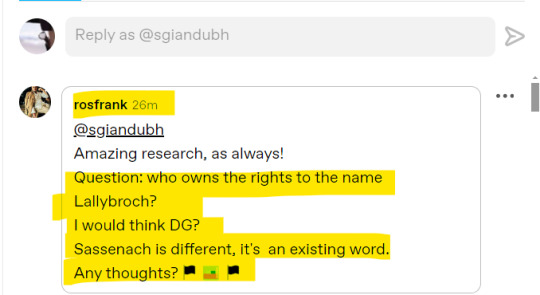
Whenever we are informally talking about 'owning the rights to something', I think it's very important to bear in mind a fundamental distinction between two different categories of ownership rights: copyright and trademark.
The copyright is the most familiar one to many of you. It is what you usually find on those annoying and apparently useless first or last pages of all the printed or digital editions on this planet. Something like this:

In the US, copyright issues are regulated by the Copyright Act of 1976, as included in Title 17 of the US Code. The US public authority competent for registering and managing copyright is, as predictable, the US Copyright Office.
Perhaps the most seminal US Supreme Court decision, as far as copyright is concerned, is the 1991 Feist Publications, Inc., v. Rural Telephone Service Co. In it, the Court ruled that mere compilations of information or facts (such as, for example, telephone books) are not protected by copyright, according to US law. In other words, the ancient legal concept of 'sweat of the brow' (which simply means the amount of work required to gather and compile those facts/information) is not enough to qualify a work for copyright protection, if no creative effort is added to enhance its content. This is why I have always considered absolutely ridiculous Marple's efforts to watermark public information screenshots: it is useless (to the extent that it legally protects her from nothing) and, as her timelines, a mere compilation of facts (legally ditto). A similar approach is preferred by the UK and also by many Roman law legal systems, such as the French one - just making things clearer, here, by the way.
See how 'Erself is roughly doing, right now, in this department:

But I am rambling. In my view, Lallybroch, as a pivotal concept used in Diana Gabaldon's books, is protected by the copyright granted to each and every of her books mentioning it, according to the Roman law principle 'accessorium sequitur principale' (the accessory follows the principal). So it will remain protected for at least 70 years since the last of her books mentioning it would have been published under copyright. Unless she chooses to separately protect the entire finished cycle as a whole, once Book Ten (fingers crossed) is published, preferably during our foreseeable lifetimes.
That being said, that goes only for one copyright category: (published) text - you cannot copyright that secret diary in your drawer, LOL. This is why, the current US Copyright Office records concerning Lallybroch look like this:

Sony Pictures Television Inc owns the copyright to the fictional name Lallybroch in the motion pictures category, as it is the title of the Episode 12, in Season 1 - DG has been handsomely compensated for this, no worries. And someone I have no idea about owns the rights to an original musical score she has written and titled Lallybroch in the music category, since October 2013.
Onwards to the trademark. This is something different and this is all about making your name/concept/idea profitable. It is all about branding it, putting it on a product and selling it under that brand. It includes all the graphic elements and the logo of the brand (accessorium...) - in short, its visual identity to the consumers. In the US, trademark issues are regulated by the 1946 Lanham Act and the public competent authority is the good old US Patent and Trade Office (USPTO).
Right now, the situation for the Lallybroch trademark is as follows:

So, we see three different trademarks: two of them, owned by Diana Gabaldon, are classified as 'dead' (cancelled and/or abandoned) and the third, Lallybroch Spirits, owned by S's Great Glen Company is pending approval - he will not be able to label any booze bottle Lallybroch Drink Me before permission is granted by the USPTO.
Let's unpack:
Both Lallybroch trademarks formerly owned by Diana Gabaldon were filed at the USPTO on February 21, 2000 and granted on December 12, 2000. The first was aimed at producing 'tartan fabrics for the manufacturer of clothing' and it was abandoned in December 2003:

The reason is that the owner did not file in any Statement of Use after the trademark was granted. She had three years to do so, and since she chose not to do anything about it, the trademark was deemed abandoned (Stacy K. Smith is the attorney hired by Herself, btw). That means she specifically implied not to intend using it in the future. As such, she may claim NO rights on a now free to use mark:

The second trademark was aimed at producing 'clothing, namely, t-shirts, dresses and headwear' and also 'jewelry, namely, rings, pins and necklaces'- to cut the story short: OL merchandise - and it was cancelled on March 1st, 2013:
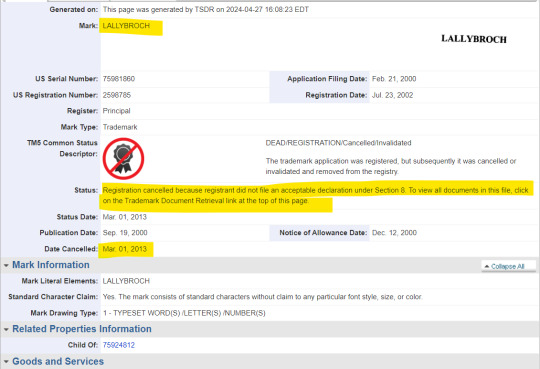
The reason is that the owner did not file the Section 8 declaration (of continuous use for five years) within the allowed legal timeframe (6 months after the fifth anniversary of the trademark granting renewal). Her trademark federal rights are now deemed canceled (but not her state law and/or common law rights!) and if she wants to ever use that name again, she would have to start the whole process over, bearing in mind the trademark could have been granted to someone else, in the meanwhile (not her case).
And for anyone who might ask, 'Erself does not own any other trademarks whatsoever:

The other (Doll Lab - LOL for ages) Diana Gabaldon is a pharmacist from Albuquerque, NM. Chill. 🤣🤣🤣
The owner of the copyright to the fictional toponym Lallybroch, as far as published text is concerned, is Diana Galabdon.
The owner of the copyright to the fictional toponym Lallybroch, as far as motion pictures are concerned, is Sony Pictures Television Inc.
The owner of the copyright to the fictional toponym Lallybroch, as a personal work of music, is Mrs. Kelly Ruth Davis, of Pennsylvania, USA.
The owner of the Lallybroch Spirits trademark will be Sam Roland Heughan, when that trademark is granted by the USPTO.
I hope this answers your question, @rosfrank. Thank you for asking.
110 notes
·
View notes
Text
Christmas Films of a Century Past
(updated!)

For some reason, I thought it would be a good idea to watch somewhere 50-60 Christmas and Christmas-adjacent silent films from before 1920 to put together a playlist for you all.
I chose these as a representative selection. My general criteria were:
Christmas should be central to the story
The plot should be novel to a modern viewer or something a modern viewer would be surprised to see so early on film
The list on the whole should have a variety of settings and narrative structures
Here’s a direct link to the YouTube playlist, if you want to watch them all in one go. (They are all shorter than feature length!)
Two quick presentation notes:
Some of the videos have music and some don’t, so you may want to check your volume level.
The intertitles for some of these films are not in English, so be sure you have captions turned on for English translations.
READ ON BELOW!
1. Santa Claus (1898) (UK)

[letterboxd | imdb]
Directed by George Albert Smith
Short and sweet, this film sees children put to bed by their nanny on Christmas Eve and Santa Claus coming down the chimbley to fill their dutifully hung stockings. Director G.A. Smith used his own patented technique of double exposure to show Santa’s arrival without cutting away from the children’s room. Santa Claus might not pack the punch of a Méliès trick film, but it’s a fun novelty and is purportedly the first appearance of Santa Claus on film.
2. The Little Match Seller (1902) (UK)

[letterboxd | imdb]
Directed by James Williamson
This one’s a quick but effective adaptation of the Hans Christian Anderson tragedy featuring impressively well-coordinated superimpositions.
3. The Christmas Angel (1904) (FR)

[letterboxd | imdb]
Directed by George Méliès for Star Film Company
The Christmas Angel follows an impoverished girl driven into the city to beg on a snowy winter night. First she’s chased away from a church by more seasoned beggars; then she’s thrown out of a poultry seller and harassed by police. On the verge of falling asleep in the snow, a rag-and-bone man rouses her and offers her help. Later, the girl passes out beside a road but is luckily spotted by a wealthy couple on a car ride. When they learn of her plight, they bring her home along with food and gifts.
Though not as fantastical as some of Méliès’ more famous works, The Christmas Angel is still highly stylized (and stylish) and features special effects that are photographed beautifully. It’s also worth noting that the version of the film included here is the American cut. The original French cut, titled Détresse et Charité (Distress and Charity), did not include the sequence with the wealthy couple and instead ends with the girl dying in the snow.
4. The Night Before Christmas (1905) (US)

[letterboxd | imdb]
Directed by Edwin S. Porter for Edison Manufacturing Company
This is the first time the poem “Twas the Night Before Christmas” was put on film. Loosely following the poem, we see Santa Claus prepare for his yearly trek while a middle-class family prepares for his visit. When Santa heads out, we are treated to an extended panning sequence with a fully painted backdrop for a mini Santa and his reindeer to glide across. When Santa arrives at the family home, he chaotically dumps presents and decorations around their living room and makes a large, decorated tree appear out of thin air. (Across many of the movies I watched to put this post together, this seems to be a favored scenario for the jolly fat man around this time—and it’s delightful.) The family then wakes to find their gifts and the film closes with Santa directly wishing us a Merry Christmas.
5. A Little Girl Who Did Not Believe in Santa Claus (1907) (US)

[letterboxd | imdb]
Directed by J. Searle Dawley and Edwin S. Porter for Edison Manufacturing Company
Even at the risk of this list being too Edison heavy, I couldn’t leave this great short out. While walking with his mother, a rich little boy encounters a poor little girl alone in the cold. They take her home to play and warm up. When the boy learns that the girl doesn’t believe in Santa because apparently Santa doesn’t visit poor children, he hatches a scheme. On Christmas Eve, the boy holds a stake out near the fireplace and takes Santa hostage, tying him up and holding him at gunpoint. The boy then forces Santa to visit the girl—going so far as shimmying down the chimney himself to let Santa in the front door. When the girl wakes up to a beautifully decorated tree, new toys, and a full stocking, she can finally believe in Santa Claus. While I’m generally not so into stories about supposedly benevolent rich people, I do love the implications this story has on how Santa Claus works and I also find the means with which the boy gets his way hilarious.
6. Il Natale di Cretinetti / Foolshead’s Christmas (1909) (IT)
[& Come fu che l’ingordigia rovino il Natale di Cretinetti / How Greediness Spoilt Foolshead’s Christmas (1910) & Il Natale di Cretinetti (1911)]

[letterboxd | imdb]
Directed by Andre Deed for Itala Film
This entry is a three-for, which I hope you’ll excuse, but I couldn’t decide which Cretinetti Christmas to share! Cretinetti, the comedic persona of filmmaker Andre Deed, is an absolute agent of chaos.
In the 1909 film, Cretinetti attempts to bring a tree home for a Christmas party. The destruction escalates wildly, culminating in an entire building falling to pieces.

If you can believe it, the stakes are even higher in the 1910 film, when Cretinetti can’t resist sneaking out of bed on Christmas Eve to snack on the candy decorating the tree. When Santa sees what Cretinetti has done, he chides him and takes him back to his workshop—which is apparently in heaven. Destruction ensues. Cretinetti then proceeds to cause havoc for Saint Peter, annoying god so much that he calls the devil to come get Cretinetti. Cretinetti is then chased to hell where demons try to cook him alive. Thankfully, spoiler alert, it was all a bad dream and he wakes up on Christmas morning with a terrible stomach ache.

The 1911 film returns to localized chaos. Cretinetti has a run-in with a mail carrier and his Christmas packages get mixed up with one of the carrier’s parcels. The parcel contains three bottles of ether which then begin to emit gasses in the middle of the family Christmas party.
I wasn’t familiar with Cretinetti before reviewing films for this list, but I’m definitely going to seek out more of Deed’s movies. Each of these films had well-executed chaotic slapstick; over-the-top in all the right ways.
7. Making Christmas Crackers (1910) (UK)

[letterboxd | imdb]
Produced by Cricks & Martin Films for Clarke, Nickolls, & Coombs Confectionery
To start, if you’re not sure what a Christmas cracker is, it’s a colorfully decorated paper tube that makes a cracking noise as you pull it open. Inside the tube is a paper hat, a joke, and/or a small toy. It’s a traditional part of UK Christmas celebrations.
This short starts as a documentary of the workers at Clarke, Nickolls, & Coombs constructing the crackers. It’s a fun thought that as early as 1910, people were interested in watching how mass-produced consumer goods were made. It’s also fun to see these skilled workers ply their trade so deftly (even though wages and working conditions were likely less than ideal). The film ends with a family celebrating around a Christmas tree topped with a functional giant cracker.
8. A Christmas Carol (1910) (US)
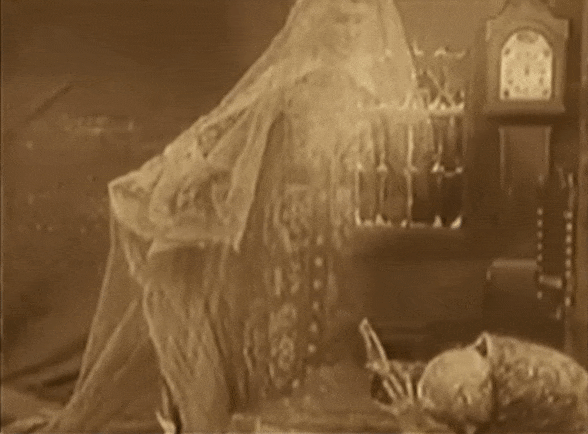
[letterboxd | imdb]
Directed by J. Searle Dawley for Edison Films Manufacturing Company
There are so so so many film adaptations of Charles Dickens’ A Christmas Carol made before 1920 that it was hard to choose which one to include on this list. In the end I chose this 1910 version for its economy of storytelling, fluid use of special effects, and for Marc McDermott’s great performance as Scrooge.
9. Broncho Billy’s Christmas Dinner (1911) (US)

[letterboxd | imdb]
Directed by Gilbert M. Anderson (Broncho Billy) for The Essanay Film Manufacturing Company
Gilbert M. Anderson was an incredibly prolific and popular filmmaker and star of early American film, particularly in his role as Broncho Billy. As was typical for Anderson, he’s pulling triple duty on Broncho Billy’s Christmas Dinner as the star, director, and producer. The film features a simple and heartwarming story.
On Christmas, Billy comes across a young woman in peril as her horses got startled and are now pulling her cart along wildly. Billy manages to wrangle the horses and in gratitude she invites him to Christmas dinner at her parents’ home. Unfortunately, her father happens to be the sheriff. But, all is well, as it turns out that Broncho Billy’s been given a pardon and the sheriff welcomes him to the table gladly.
The enduring appeal of outlaws or criminals getting into the Christmas spirit is fascinating to me and it’s cool to see such an early instance of the story!
10. Le Noel de la princesse / The Little Princess’s XMas Gift (1911) (FR)
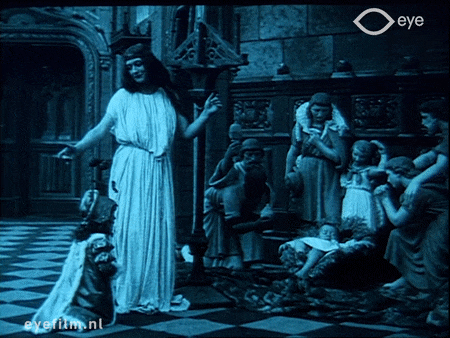
[letterboxd | imdb]
Produced by Société Générale des Cinématographes Éclipse
In all honesty, this is the least Christmassy (but also probably most christian-y) of all the films I included here, but its style and novelty stood out. The sets, costuming, and production design are lush. It might also be one of the weirdest Christmas stories I’ve even encountered.
After Lord Othberg passes away, the conniving Otto plans to assassinate the baby prince in order to inherit the lordship himself. He poisons the baby, but the princess prays for her baby brother to come back to life as her Christmas gift. An angel appears to her and they summon Jesus, who resurrects her baby brother. Of course, they then place the revivified baby in the castle’s nativity scene, to the joy of all but Otto.
11. Ida’s Christmas (1912) (US)

[letterboxd | imdb]
Directed by Van Dyke Brooke for Vitagraph Company of America
With a more classic Christmassy story, Ida’s Christmas tells us of a family who are facing hard times. Ida (played by a very small Dolores Costello) has her eyes on a pricey doll. Meanwhile, her mother seeks out employment with a wealthy family. The matriarch of the wealthy family overhears Ida’s wish and decides to buy the doll for her as a surprise. Later, Ida is distraught to find that the doll has been purchased but comes across a wallet that someone has dropped. She considers taking the money, but chases down the owner instead. The old man gives her some reward money for returning the wallet. Ida rushes to see if she can buy the doll, but has second thoughts when she thinks about how much her family could use the money. She arrives home with the money just in time for a Santa-esque old man to show up bearing packages and an assurance that the wealthy family has work for her father. The film ends with the family celebrating an unexpectedly Merry Christmas.
It’s a sweet story that hits so many beats of what we now consider traditional Christmas tales.
12. Рождество обитателей леса / The Insect’s Christmas (1913) (RU)
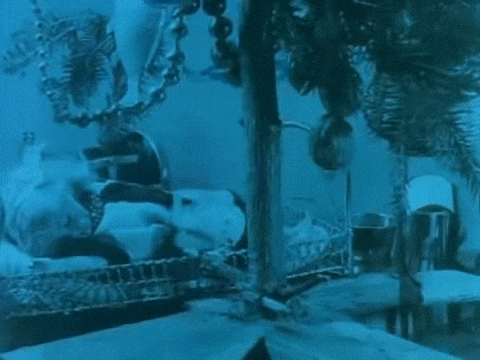
[letterboxd | imdb]
Directed by Władysław Starewicz for Khanzhonkov
Fair warning, if you thought The Princess’s XMas Gift was odd, you might need to ready yourself for this one. Stop-motion virtuoso Władysław Starewicz (Ladislas Starevich) spins a tale about a tiny ornament of Santa/Ded Moroz coming to life on Christmas and going out into the wild to bring Christmas joy to creatures small and smaller, including a frog and a ladybug. Starewicz’s animation is as impeccable as ever and the short is imaginative and quirky.
Honorable Mention:
Dance of the Seasons (1900)
Christmas Dream (1900)
Christmas Eve (1913)
A Christmas Carol (1914)
Snow White (1916)
A Winter Straw Ride (1906)
#1900s#1890s#1910s#silent cinema#classic film#classic movies#film#silent film#my gifs#silent movies#christmas movies#christmas#film history#american film#russian film#french cinema#cinema italiano#british film#cinema#classic cinema#film recommendation
31 notes
·
View notes
Text
The Red Circle
Published in 1911 as a two-parter, this is the penultimate story we'll be covering His Last Bow, leaving just the titular story there.
This does sound rather like "The Veiled Lodger", doesn't it?
These days, you'd have to check the immigration status of your tenants. In 1902, really not an issue. Although anti-immigrant sentiment was definitely there and growing.
Those strange coded personal messages - some even encrypted - very much existed in newspapers back then. Once radio had become a thing, the British would use them on radio broadcasts to Occupied Europe in the Second World to get messages to the resistance movements. Including the "get ready" and "go" codes for the mass sabotage operations that preceded Operation Overlord in 1944.
"Timekeepers" were used for recording arrivals and departures at a site, including that of staff for the purposes of paying wages, determining lateness etc.
Great Orme Street is more properly called Great Ormond Street, located in Bloomsbury. It is best known for the world-famous children's hospital called Great Ormond Street Hospital. They have a permanent UK copyright to Peter Pan which gives them a right to royalties for publications, adaptations, performances etc. The US copyright on the original version expires next year. If anyone wants to do a LfW retelling of the original book, it would be nice to contact them and arrange a donation. They're a very good organisation.
"Art for Art’s sake" was a French slogan from the latter half of the 19th century. You may know its Latin version - ars gratia artis - as the motto of film studio MGM.
The light flashing message gets a whole chapter covering it in Klinger's annotated version, as it's been heavily discussed by scholars. Basically, it would take multiple minutes to send that message.
The Pinkerton detective agency did a lot of investigative work in its early days, both criminal investigation and more nefarious stuff to aid strike-breaking. The latter got the US government banned from hiring them as such in the 1893 Anti-Pinkerton Act. They are still involved in anti-union stuff today.
Much of Notting Hill had become increasingly slum-like by this time as an influx of people led to houses built for one family being split to hold far more; the idea when the area was built was for the middle classes to live there, but they didn't buy the properties. It later attract large numbers of Afro-Caribbean immigrants in the post-war era, partly as the notorious slum landlord Peter Rachman was prepared to rent to them while others weren't. This growing ethnic tension culiminated race riots in 1958, with white "Teddy Boys" attacking West Indian homes. Since then, the slums have been cleared and the area has gentrified quite a bit.
It is also home to the annual Notting Hall carnival every August since 1965 (bar 2020 and 2021), which around 2 million people attend. The Metropolitan Police have moved from active hostility to active cooperation in its running and there will be photos of officers dancing with those in the parade at any given carnival. The reputation for violence is unjustified and arguably fuelled by racism - while there were frequently arrests for violence, drugs and weapons offences, on a pro-rata basis, the arrest rate is about the same as the Glastonbury Festival.
The Carbonari ("charcoal makers") were secret revolutionary societies active in what would become Italy in the early 19th century. After failed uprisings in 1831, the various Italian governments cracked down hard on them and they were effectively eliminated. They were not really engaged in protection rackets.
Dynamite was patented by Alfred Nobel in 1867. Being a good deal more stable than nitrogyclerine - although storage is important as old dynamite is a good deal less stable - it became popular for terrorists and criminals, with a series of bombings by Irish republicans between 1881 and 1885 leading to the formation of Special Branch.
Covent Garden is home to the Royal Opera House.
30 notes
·
View notes
Text
wai as a faen fatale: a defense
thank you, as always, to @absolutebl for inventing the term
A faen fatale is a character whose purpose is to drive a wedge between the main pair by pursuing on of the main pair. They generally do not receive much character development themselves. Faen fatales can be of any gender, though typically the seme is pursued by a woman and the uke is pursued by a man.
Bad Buddy is not a show with typical faen fatales - I’ve already spoken at length here about how Ink subverts the idea of a faen fatale by not being interested in either lead and by receiving lots of character development of her own (including her own romantic arc), but I would like to throw my hat in the ring for Wai as a faen fatale.
To start, let’s look at the role of a faen fatale in a BL show. They will:
be romantically interested in one of the leads and pursue them
induce feelings of jealousy and other negative emotions in the other lead
become a barrier to the leads’ relationship (e.g., one doesn’t trust the other there are no actual feelings/a relationship between them, the jealousy gets out of hand, etc.)
become a catalyst for the leads’ relationships (e.g., the feelings of jealousy make a lead realize his feelings/act on his feelings, combating the faen fatale brings the couple together, etc.)
Let’s assess Ink with this list:
1. no, she isn’t romantically interested in either Pat or Pran (or guys at all for that matter)
2. yes, Pran does feel jealous and sad because he assumes Ink and Pat are together/will be together, and because Pat told him he has a crush on Ink; Pat intentionally uses Ink to make Pran jealous during the ep.7 Flirt-Off bet while they eat at the noodle shop (he opens the water for her, he tries to feed her, he take a picture with her, etc.)
3. yes, as part of Pran’s initial hesitation to start a relationship with Pat/go beyond the rooftop kiss is his understanding that Pat has feelings for Ink and that they are well on their way to being together
4. yes, in some ways, as Pat uses Pa’s patented “Four Ways to Tell is Someone is Into You” she taught him to asses Ink to realize his own feelings for Pran, and Ink is generally supportive of Pat and Pran’s relationship (both before they were romantically involved and after)
Bonus: Ink is the faen fatale for Pat, who is the more traditionally seme coded character, and semes typically have female faen fatales
Despite this, Ink doesn’t fit the model of a faen fatale because, well, she doesn’t actually pursue either lead, and because she gets much more character development (including her own completely separate romantic arc) compared to other faen fatales.
Ok, now let’s asses Wai with this list.
1. no, he isn’t romantically interested in either Pran or Pat
2. yes, Pat does feel jealous and sad at Wai and Pran’s closeness, and how Wai is able to openly be friends with Pran (even visiting his house) in all the ways Pat can’t; Pran intentionally uses Wai to make Pat jealous during the ep.7 Flirt-Off bet, e.g., when they eat at the noodle shop (he orders Wai’s favourite dish without even having to ask, he feeds him, he wipes his face, he feigns helplessness to get Wai to help him with his water bottle, etc.)
Pat being jealous of Wai, a moodboard:












Pat being jealous of Wai (and Pran knowing and milking it), a moodboard:













3. yes, Wai (along with the rest of the architecture and engineer friend groups) is one of the main barriers to Pat and Pran’s relationship. He is against them interacting as friends and certainly against them being together romantically, even outing them to their friends and classmates. Pran and Wai’s friendship suffers after Pran and Pat’s relationship is revealed, which causes Pran pain to the point that Pat offers to (pretend) break up with him in order to repair their friendship.
4. yes, as Pat’s jealousy towards Wai is one of the reasons he realizes he likes Pran as more than a friend, and because Pran and Pat come together in the face of Wai (and their other friends)’s disapproval (e.g., Pat offering to be the heartbroken one and pretend Pran broke up with him to repair Wai and Pran’s friendship, a moment where Pran realizes the extent to which Pat will go for him)


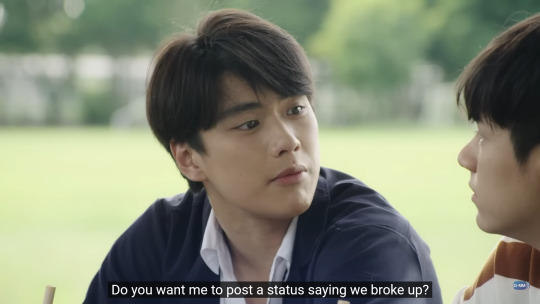

Bonus: Wai is the faen fatale for Pran, who is the more traditionally uke coded character, and ukes typically have male faen fatales
Ergo, if we say Ink could be a faen fatale, clearly Wai could be too.
In fact... if I dare say... there’s more of a case for Wai to be a faen fatale than Ink? No... I shan’t say...
Second argument: it’s hilarious.
Wai, the faen fatale who doesn’t realize he’s the faen fatale. Look at his reaction when Pran uses him to make Pat jealous at the noodle stand:

He’s baffled but sure he’ll let his friend wipe his face and take care of him. He doesn't even know he's in a BL at this point (to him, Bad Buddy is an action series about Architects vs. Engineers).
My case rests.
Bad Buddy is an incredible show, especially in its subversions of BL tropes. This extends to their "faen fatales: Ink, who isn’t really a faen fatale because she has her own complex interests, and Wai, who isn’t really a faen fatale and has no idea what is going on.
#bb#bb meta#bad buddy#ranch thoughts#to be clear I am being 100% serious about this and also I find it really funny#I also support this theory bc to me Jimmy is at his best when he is most pathetic - hope this helps#today I give you: 5k on trope subversions in Bad Buddy and MSP with academic references#also today: I give you 900 words on Wai supported by so many image Tumblr crashed multiple times#my range
100 notes
·
View notes
Text

By: Jo Bartosch
Published: Apr 21, 2024
How did people emerge from the hysteria of the witch trials? What must it have felt like to live through the period when supposed witches were suddenly revealed to be ordinary women? What did the accusers say when it became clear that these supposed agents of Satan were simply adult human females? Did they feel guilt and try to make amends? Did they shirk their responsibility? Or did they double down?
The reactions to the publication of the Cass Review last week might give us some idea. The activists, medical professionals and celebrities who championed the trans cause have been confronted with the horror they helped create. Dr Hilary Cass’s report into the NHS’s treatment of gender-confused kids has radically transformed the trans debate, exposing ‘gender-affirming care’ as a dangerous experiment. Now, the disciples of trans ideology are scrambling to save face.
The most common reaction from cheerleaders of trans ideology has been to meekly plead ignorance. One such case is that of Dr Adam Rutherford, geneticist, science communicator and president of Humanists UK – an organisation that in recent years has made a hard turn away from science and rationality in favour of worshipping the cult of gender identity. Yet when he was invited to comment on the Cass Review by Sex Matters director Maya Forstater on X, Rutherford said: ‘It’s not something I know much about.’ Really? It’s somewhat difficult to believe that Rutherford has somehow missed seeing this bit of hugely significant medical news.
This is mirrored by the bleating entreaties for ‘nuance’ from television presenter Kirstie Allsopp. For the past few years, Allsopp has smeared gender-critical views as transphobic. Now she is attempting to rewrite history by claiming that it has always ‘been possible to debate these things and those saying there was no debate are wrong’. We all know this isn’t true. As JK Rowling correctly points out, ‘one of the gender ideologues’ favourite slogans is “no debate”’.
Perhaps the most egregious response of all has come from former Stonewall CEO Baroness Ruth Hunt. It was Hunt who oversaw the charity’s transformation from a gay-rights charity to an LGBT lobby group, with the emphasis firmly on the T. It was under her watch that Stonewall tried to silence warnings about the dangers of experimental puberty blockers. Yet last week, Hunt told The Times that she had simply ‘trusted the experts’ on puberty blockers and cross-sex hormones, so she couldn’t possibly be held accountable. Given that Stonewall itself was deferred to as an ‘expert’ organisation on the issue of gender-affirming care, it is hard to accept Hunt’s projection of innocence. She was hardly some misled ingénue.
Even more deranged and delusional are those who have dismissed the Cass Review as ‘unscientific’. Apparently, Cass’s four years of research and the reams of data she gathered are simply a pretext for promoting a ‘transphobic’ narrative. This rejection of reason is perhaps most eloquently demonstrated by the hyperbolic hashtag, #CassKillsKids, which has been tweeted out by the likes of broadcaster and trans activist India Willoughby. But this position is so patently untrue that only a small minority of the most committed zealots seem to be defending it.
The fact is, it is incredibly difficult for trans activists to obscure their roles in this scandal. Many of them must now be aware that they cheered on a gruesome, ideologically motivated experiment on children. After all, the facts are now indisputable.
In measured tones and meticulous detail, Cass’s report reveals what was really going on inside the NHS’s Gender Identity Development Service (GIDS). She concludes that the ‘gender affirming’ medical treatments it provided, like puberty blockers and cross-sex hormones, are based on ‘wholly inadequate’ evidence. Doctors are usually cautious when adopting new treatments, but Cass says ‘quite the reverse happened in the field of gender care for children’. Instead, thousands of children were put on an unproven medical pathway. Worse still, medical professionals seemed largely uninterested in uncovering the side effects and long-term risks of these drugs. Cass says that all but one adult gender clinic refused to share patient data that would allow her team to study how childhood transitioners fared as adults. This made it virtually impossible to research the potential longer-term consequences of transitioning.
The implications of the review are so grave that politicians have had no choice but to act. On Monday, health secretary Victoria Atkins gave an excoriating speech to parliament, laying out the changes in policy that have already been made and those still to come. She reiterated that NHS England would no longer be able to prescribe puberty blockers for children with gender dysphoria outside of clinical trials. She also promised a crackdown on private prescriptions, as well as an urgent review on clinical policy for prescribing cross-sex hormones. Vitally, she also announced that NHS trusts that initially refused to cooperate with the review will now share their data, hopefully opening the door for further research. These developments were all sorely needed.
Atkins also made a point of thanking the clinicians, academics, activists and journalists who raised the alarm. She acknowledged that they had ‘risked their careers’ to do so. She told her fellow politicians that it should trouble each of them that the NHS ‘was overtaken by a culture of secrecy and ideology that was allowed to trump evidence and safety’.
Finally, politicians are taking these concerns seriously. Until very recently, they did not want to know. Back in May 2019, I was one of a handful of people to attend the First Do No Harm meeting at the House of Lords. There, in a tiny cramped room, we listened to clinicians and campaigners who were desperately worried about the goings on in the GIDS Tavistock clinic in London.
First Do No Harm was organised by campaigner Venice Allan and Let Women Speak founder Kellie-Jay Keen (aka Posie Parker), with the aim of bringing together journalists, politicians and medical experts. It was chaired and spon.sored by Labour peer Lord Lewis Moonie, who himself had a background in psychology and clinical pharmacological research. Among the attendees was psychoanalyst Marcus Evans. He had resigned from his post as a governor at the Tavistock clinic in February that year, citing concerns about the influence of lobby groups on clinical practice.
Despite this wealth of knowledge and expertise, First Do No Harm went largely ignored by politicians. Invitations were sent out to every member of parliament. But, aside from Moonie, the only politicians in attendance were Baroness Tanni Grey-Thompson and Conservative MP David Davies. As Evans explained at the time: ‘No one would basically attend, they’d be threatened that they would have the whip withdrawn if they attended… the silencing of opposition in this area is unbelievable.’
There was certainly a cost for Moonie. After over 40 years in the Labour Party, he was told by party general secretary Jenny Formby that his membership would be at risk if he proceeded with the event. So he resigned. Five years on, and the concerns of Moonie, a small band of whistleblowing clinicians and tenacious campaigners have finally been acknowledged.
While First Do No Harm was the first public meeting bringing concerned voices together, staff within GIDS had already been sounding the alarm for some time. It was all the way back in 2004 that Susan Evans, wife of Marcus, first spoke out about the ‘precipitous referral’ of gender-confused children on to a medical pathway. As a clinical nurse at the Tavistock, she tried to raise the possibility that there were alternatives to medically transitioning children. But she was advised that GIDS would be unable to attract patients without offering puberty blockers. Evans resigned in 2007.
Today, Evans tells me that, while she is relieved about the findings of the Cass Review, she is frustrated to see ‘what happened at GIDS described as a debate between two sides’:
‘I wanted to ensure that kids were receiving a thorough assessment and that as a team there would be a more holistic exploration… That’s not a toxic debate, that is clinical discussion and that’s what a responsible clinician ought to do. All I ever did was raise ordinary but important clinical and safeguarding concerns and questions. I was inquisitive.’
Thankfully, there were still some other inquisitive clinicians out there. In 2018, Dr David Bell, consultant psychiatrist and staff governor at the Tavistock, wrote an internal report that slammed GIDS for promoting a model of uncritical gender affirmation. He blamed trans lobby groups like Mermaids and Stonewall for infecting the organisation. He also explained that many of the young patients seeking to medically transition would otherwise grow up to be lesbian, gay or bisexual. For this, senior management at GIDS threatened Bell with disciplinary action, in an attempt to silence him.
Shortly afterwards, in 2019, clinical psychologist Kirsty Entwistle, who had previously worked at the GIDS satellite clinic in Leeds, penned an open letter, echoing similar concerns. She warned that patients were falsely being told that puberty blockers were ‘fully reversible’ and that accusations of transphobia were stifling important medical and safeguarding discussions.
GIDS was desperate to silence anyone who expressed doubts about how clinics were operating. One such whistleblower was Sonia Appleby, who was a social worker and safeguarding lead at the Tavistock. In 2016, Appleby began to raise concerns about the shambolic record-keeping and the potential over-prescription of puberty blockers. For this, she was bullied and monstered by management, and shunned by GIDS director Dr Polly Carmichael. Carmichael apparently told her team that Appleby had ‘an agenda’ and discouraged staff from sharing any safeguarding concerns with her. In a small act of justice, in 2021 Appleby was awarded £20,000 in damages for the appalling way she was treated at the Tavistock.
Many of the stories from those who spoke out chime with one another. They talk about being alarmed that children’s underlying issues were being systematically overlooked. GIDS was more interested in prescribing medical treatments than in helping children who were suffering from homophobic bullying, mental-health issues, sexual abuse or other traumas. When questions were asked about the safety of puberty blockers and hormones, staff faced an atmosphere where clinical curiosity was discouraged. In all, between 2016 and 2019, a total of 35 clinicians left the Tavistock, with many citing concerns about children being over-diagnosed. Meanwhile, management ignored all these concerns and children continued to be prescribed puberty blockers.
It was shortly after Carmichael’s appointment in 2011 that GIDS began its first trial of puberty blockers. Before the research had even concluded, these drugs, which have also been used to chemically castrate sex offenders, were made more widely available to children. In 2014, the minimum prescription age was dropped from 16 to 11. Some private clinics even started prescribing them to children as young as nine.
GIDS management, it seemed, was remarkably unbothered by the lack of evidence for puberty blockers. In 2016, Carmichael told a World Professional Association for Transgender Health conference in Amsterdam that they were crucial for trans-identified kids and ‘incredibly successful’. But in the same speech, she admitted that ‘actually, the Dutch are the only team really who have published long-term perspective studies about this. So there is very little data available.’ Indeed, as Carmichael admits, virtually the only bit of evidence ever referenced in support of puberty blockers is a piece of flawed research from the Netherlands. It was later revealed that the findings from GIDS’s own puberty-blocker trial were far from reliable.
It was left to those on the outside to bring public attention to what was happening at GIDS. Yet, just as with the silencing of clinicians, those outside the medical profession were also smeared as transphobic for questioning the new wisdom about so-called trans kids.
One of the earliest groups to demand an evidence-based approach was Transgender Trend, which was founded by Stephanie Davies-Arai in 2015. She and her organisation were almost instantly hounded and derided by trans extremists. A children’s book published by Transgender Trend was even compared to ‘terrorist propaganda’. But this smear campaign wouldn’t stop the truth from being revealed. Transgender Trend soon attracted the attention of Oxford professor Michael Biggs. In 2019, he published a report with the organisation, showing that the use of puberty blockers did not reduce the mental distress experienced by patients – a conclusion now backed up by Cass.
This reality became impossible to ignore, especially as ‘detransitioners’ began to speak out. The existence of people who regretted their decision to transition proved to be a thorn in the side of the trans movement and a powerful testimony against so-called trans healthcare. In November 2019, a women’s rights group called Make More Noise hosted the first panel discussion of detransitioners in the UK, giving them an opportunity to share their stories with journalists. With testosterone-cracked voices and mastectomy scars, these young women embody the harms of gender medicine. They were the ‘data’ that the clinicians at GIDS had overlooked.
Detransitioners fought to make themselves heard. In 2020, a high-profile legal challenge by detransitioner Keira Bell against the Tavistock prompted NHS England to commission the Cass Review. Leading paediatrician Dr Hilary Cass was then tasked with finding out what was really happening at GIDS.
Detransitioner Sinead Watson, who, as a young adult, took medical steps to present as male, is one of those who gave evidence to the Cass Review researchers. She tells me: ‘They asked about my story, how I was evaluated, how quickly, about the side effects of [testosterone] and about the surgery. They asked how I was helped to deal with the regret when I sought out support from the NHS, and seemed genuinely surprised I had received no help.’
It truly is a scandal that children and youngsters were put on a pathway to medicalisation and then promptly abandoned. There are now calls for a public inquiry, and it looks like adult services will also now face their own Cass-style review. But the problem with the trans ideology is that it extends far beyond medicine. It is a mind virus that has infected almost every British institution.
Certainly, there can never be true justice for detransitioners. They will continue to carry the mistakes of the medical establishment, and the failure of the government, on their bodies. It also seems unlikely that any of the whistleblowers who were vilified for raising the alarm will receive apologies or retractions. Trans cheerleaders will continue to deny any complicity. No doubt the GIDS management and healthcare professionals who tried to suppress the truth will be able to slink off to lucrative careers elsewhere.
Still, the Cass Review has revealed that the witches were right. Its publication ought to mark a historical turning point, and serve as a reminder that truth can win out. We must remember all this when the next hysterical mania sweeps over society.
#Jo Bartosch#Cass Review#Cass Report#Hilary Cass#Dr. Hilary Cass#Tavistock#GIDS#medical scandal#medical corruption#medical malpractice#ideological corruption#ideological capture#gender affirming care#gender affirming healthcare#gender affirmation#queer theory#gender identity ideology#gender ideology#intersectional feminism#religion is a mental illness
11 notes
·
View notes
Text
Can a peerage be removed?
Yes, it is possible to remove a peerage. However, as described in Gadd’s Peerage Law, once the Crown has granted a peerage it is “very difficult to deprive the holder of it”.
Peerages are created by letters patent: a legal document issued by the Sovereign and adorned with the Great Seal. The Great Seal (formally known as the Great Seal of the Realm) is the chief seal of the Crown. It is used to show the monarch’s approval of state documents. As explained in Halsbury’s Laws of England, the Crown does not have the power to cancel a peerage once it has been created.
A peerage can only be removed by an act of parliament. The most recent act that did this was the Titles Deprivation Act 1917 (TDA).
Celta, the above excerpt is from <lordslibrary.parliament.uk> re: who has the authority to bestow/create peerage titles (the Crown, by Letters Patent) and who has the authority to then remove peerage titles (Parliament, by an Act of Parliament).
I agree that the removal of the Sussex titles should be the result of an egregious/treasonous act (by the Sussexes) that is supported by objective, hard evidence and that cannot be gaslighted by them as being r*cially motivated. Objective, scientific proof of surrogacy concerning A’s/L’s births (eg, DNA or medical records) would do the trick. Interfering in the LoS is treason, yes?
*
Hi Nonny,
I have discovered that apparently there is a difference between normal peerage titles (to which the above applies) and royal peerage titles, and apparently The King can remove the royal peerage titles but not the normal ones. I know the HRH Prince/Princess titles have to be removed by the King; parliament can not touch those AFAIK.
Objective proof of the surrogacy should do the trick, in my mind at least. Somewhere (and I have no idea where, and I can’t find it again) I remember reading a piece of legislation of the UK that said, clearly, that any attempt to interfere with the Line of Succession results in that person and their children being removed from the Line of Succession. A concealed surrogacy is definitely an attempt to interfere with the Line of Succession imo, as surrogate children are not eligible to be in the Line of Succession by law, and so if that is proven then under UK law Harry will lose his place in the Line of Succession and so will his kids. That would be another reason to remove the titles - you don’t need an HRH Prince/Princess when you are no longer in the line to the throne, do you?
9 notes
·
View notes
Text
Driving an Edison
The image below was share by @steinkobbe.
I write A LOT about Tesla in CLOCKWORK FUTURES. Fascinating guy. But never a businessman. He even gave a speech at Niagara saying all electricity should be free.
Edison was a businessman. He had a lab where many inventors and engineers worked to perfect ideas that (by contract) then belonged to Edison. Meaning when Edison wrote, pithily, “ I didn't fail. I just found 2,000 ways not to make a lightbulb; I only needed to find one way to make it work.” What he really meant was ‘I needed a bunch of people under me to work late until they found a way to make it work.’ PS: a British inventor named Joseph Swan invented the first lightbulb; Edison et al. Improved it with better vacuum and filament. Swan sued Edison over patent infringement, upheld in UK.
Other Edison notables: he also mounted a propaganda campaign against Tesla and Westinghouse, and electrocuted an elephant named Topsy in 1903 to ‘prove’ that alternating current (his rival’s tech) was too dangerous. HE ELECTROCUTED AN ELEPHANT.
So… Edison stole ideas, made other people do the work while he got credit, convinced the world he was a genius, AND used media and propaganda to attack his rivals. Which means:
If it’s a car sold by Musk, its more appropriate to call it an ‘Edison.’

18 notes
·
View notes
Text
What Fuel would NWR Steam Engines use Today?

This is a question that I think a lot of people in the fandom are asking, especially with ever-more stringent environmental laws, the war in Ukraine cutting off Russian coal and the end of coal mines in the UK and the western world.
So, what exactly are Sodor's options if Sir Topham Hatt wants to run a steam railway in the 21st century.
I will do a separate post based on what I think the Fat Controllers do to ensure their engines run safely and profitably into the 2020's, but this post is all about fuel. Now, let's talk options:
1: Coal:
This is what Sodor is already using, and is the option that I think Sodor would enter the 2000's with. However, the UK has been rapidly closing coal mines since then, with the last deep coal mine in the United Kingdom, Kellingley colliery in North Yorkshire, closing in December 2015, and many of the mines that produced engine-grade coal already being closed. From this point on, the NWR has two options really: American anthracite coal (which is in decline) or Russian anthracite coal. Most British heritage railways used Russian coal due to its cheap and plentiful nature, leading to their current predicament of skyrocketing prices caused by tariffs and a cut-off from the Russian coal supply. Polish coal is an option some railways are switching too, however this is also quite expensive and not as plentiful as the previous coal.
Another option would be Australian bituminous coal, which is a worse coal for engines but is far cheaper and more plentiful. This would be unlikely, but could potentially be used as a desperate measure by the railway while searching for a better and more permanent option. Remember, bad coal causes a lot of havoc on Sodor even when considering different grades of anthracite coal.

2: Electricity:
If you've ever watched Train of Thought's video on electric steam (find here), then you may just know what I'm about to suggest. During the 1940's, the Swiss Federal Railways (SBB) converted a pair of steam engines with pantographs and used the electricity to boil the water. There was also a patent taken out in Canada as recently as 1992 for a steam engine that uses electricity to boil the water.
The pantograph part of the design would not happen - as much as Sodor has updated and modified their engines, whacking a pantograph on them would be crossing a line. So, what are the other options? Well, they could potentially use a third rail, and hide the converters and other pieces inside the bunker or tender, with what space remains being a perfect spot for extra water storage. Another option is batteries in the place of the bunker or tender, this in essence turning the engines of Sodor into battery engines.


The issue here is that the batteries are not really very efficient above the size of a Tesla, and a third-rail system has the potential to cause issues with any safety equipment on the ground (GWR had problems with their AWS system when travelling near the Southern Railway or the London Underground).
The battery version is something I could see being implemented on branchline and shunting engines however, as they could stay near charging ports and best utilise the extra range and lower emissions such a change would bring, without having as many drawbacks. Another advancement would be using an electric battery to preheat the boiler and to power the electrics in the coaches.
3: Biodiesel:
Before anyone goes insane about the idea of converting the NWR engines to oil-fired, I think I should say that I mean torrefied biodiesel pellets, as tested by the CSR in the USA on steam locomotives since as early as 2016 (article linked here). Torrefied biodiesel pellets have similar qualities to coal, including the fact that they can be shovelled and stored similarly to coal.

They don't really look that different to coal, do they? And in this trial, the engine they were trialling it on (Milwaukee County Zoo Train No. 1924) not only ran on 100% torrefied biodiesel, but also reached just under 200PSI. CSR has also ran tests on standard gauge engines, and the fact is that the Skarloey Railway would probably be an early adopter.
Furthermore, Sodor is a primarily agricultural island, and due to globalisation, the farms would be looking to find new crops with which to make a profit from, as the prices of cheap international products hurts their smaller farms. The NWR looking at biofuels would be a golden opportunity for them, and the NWR would have the crops needed for biodiesel locally, decreasing shipping costs.
The issue with biodiesel as a fuel is that it does not burn as hot as conventional coal, and it burns quicker. It does however start burning sooner, meaning setting a good fire in the mornings would be easier.

Railways using steam power are currently being faced with these major issues, and Sodor would probably be at the forefront of the debate, as its heavy usage of steam and early diesel engines makes for problematic encounters with environmentalists. However, Sodor would also be one of the largest supporters and financers of steam research, and would, in my opinion, use a mix of electric steam and biofuels to preserve their fleet of engines well into the 21st century. And yes, it would be theoretically possible to create an entire scientific essay out of this.
One again, pictures are not mine, and remember to tell me your ideas!
#ttte au#ttte analysis#thomas the tank engine#skarloey railway#coal mining#biodiesel#electric#steam engines are beautiful#steam engines#Milwaukee country zoo engine#railways#railway series#2010s issues#heritage railway#electric steam#switzerland#This is just what I do on Tumblr now it seems
43 notes
·
View notes
Text
Mathew Baynton: ‘I sometimes think the culture wars only happen in people’s minds’
As he prepares to play Bottom at the RSC, the Ghosts star talks about why making comedy in the UK is no laughing matter

Before I meet Mathew Baynton I’m half expecting to encounter a version of the Regency poet he played with such expressive romanticism in the BBC’s exquisite hit sitcom Ghosts. Or the flamboyant rapping Charles II, just one of the many historical characters the collective reimagined with antic gusto in the children’s TV series Horrible Histories. Or even the fabulously reptilian Mr Fickelgruber from the recent blockbuster hit Wonka. In other words, surely an actor renowned for playing delicious Technicolour caricatures would be a bit outsized himself?
Instead when we meet at the RSC rehearsal studios in Clapham, Baynton slides along the wall as though trying to disappear into the paintwork. “I don’t like entertaining people socially,” he says apologetically. “At a recent wedding I was too shy to dance. I’d have no hesitation dancing my socks off in a show and looking very silly, but not at a wedding thank you very much.”
Baynton, 43, is about to play one of the silliest characters in the western canon, Bottom, the hapless, deluded wannabe actor in A Midsummer Night’s Dream at the RSC. It’s Baynton’s first theatre gig in 10 years. The reasons he hasn’t trod the boards for so long are perhaps predictable – the combination of screen and family commitments, he says: he has two children, 12 and eight, with his partner, the film historian Kelly Robinson. But also perhaps because no other stage role until now has made him think that “if I said no, I might spend the rest of my life wondering if I’d made a massive mistake”.
He’s been relieved to discover the Mechanicals, the amateur acting troupe of whom Bottom is arguably the least talented, are not the “beer-swilling rotund yokels with West Country accents” he remembers from mediocre productions in his youth. “My feeling with Bottom is that someone once said to him he was quite good at acting, and that’s been enough to make a monster out of him. He has precious little experience but just enough to make him think he can do it all. My Bottom will be ridiculous. But there is a real sweetness to his enthusiasm.”
Baynton is very good at finding the sweetness in the patently ridiculous. It’s there in Ghosts (which he co-created) about a mismatched bunch of spectral beings trapped together in a crumbling old house and whose final episode after five seasons last Christmas attracted 6.6 million viewers. There was an endearing bumbling charm to his pathologically helpless Berkshire county council worker Sam Pinkett in the 2013 cult sitcom The Wrong Mans, which he developed with James Corden. Even Fickelgruber wasn’t too menacing.

Surely, though, he would have been even better casting as Wonka himself? “Er, I don’t quite have the global reach of Timothée Chalamet,” he splutters. “Although, a bit like Bottom, I always think: I’d have a go at that!” He adores the way the film embraces old-fashioned spectacular storytelling. “It’s lovely to see budget being used for big choreography and lots of people dancing in a town square, and not just explosions and fights which are usually the things budget buys.”
He deplores, though, how hard it is now to get original family blockbuster entertainment greenlit. “I grew up in a golden era of that sort of thing – ET; Back to the Future. These days you can’t do anything in that area that doesn’t have existing IP. You need to give the financiers a pre-existing brand. You can’t say ‘I’ve written this idea about this kid who is friends with a crazy scientist’ and hope to make it into a big film. And that is very sad.”
You can, though, just about, still pitch original ideas with cross-generational appeal to TV. Ghosts was a rare example of a TV sitcom that enthralled adults as much as it did their children. What’s more, it did so with almost surreal placidity. In a cultural climate that seems to trade on people being as loud and divisive as possible, Baynton’s faith in an inclusive gentle comic mayhem feels positively subversive.

“Everything these days is designed to agitate because agitation is the quickest way to get someone’s attention,” he says dispiritedly. “In season two of Ghosts, we had an episode featuring a gay marriage, much to the outrage of Lady Button. But eventually she realised that the unhappiness in her own marriage stemmed from her sexually repressed homosexual husband. Softly softly, there is a thesis there. Which is that if we could just put our f---ing phones away and sit down with each face to face and talk, then [these polemical attitudes] will loosen.”
Baynton grew up in Southend, the youngest of three brothers, and spent an awful lot of time watching Monty Python and Dad’s Army with his father. He attended Rose Bruford College and then trained in clowning at the Ecole Philippe Gaulier in Paris. His first major professional success was Horrible Histories, which ran for five years from 2009; around the same time he started working with James Corden.
“We immediately hit it off,” Baynton tells me. “We were laughing at similar things,” Corden wrote him a part in Gavin and Stacey and Baynton then approached him with the idea for The Wrong Mans. A classic British sitcom pretending to be a Hollywood thriller, in which two jobsworths find themselves inadvertently embroiled in a fast-spinning web of crime and conspiracy, like much of his work it’s quietly radical.

“I had this bee in my bonnet about how comedy at the time was never allowed to have high production values. You had single-camera family sitcoms and you had brightly lit studio sitcoms but never anything that looked like a Coen brothers movie because the budgets are so low. So we thought, if we write something along those lines with James in it, maybe someone would take a punt. But the BBC said they couldn’t afford it. They said, either you rewrite it, or we junk a lot of it. So we went to America. In the end, it became one of the first America/UK co-productions [it was a co-production between BBC Two and the US streaming platform Hulu]. And that’s now become a widespread model.”
Baynton seems to be permanently busy: he’s currently writing a comedy film, which he can’t discuss, and this year will appear in the BBC’s forthcoming adaptation of Holly Jackson’s young adult thriller A Good Girl’s Guide to Murder. He worries, though, for the future of comedy on TV. “For the sixth year running Ofcom has labelled scripted comedy [at the BBC] to be at risk,” he says. “The amount being produced is at an all-time low. I know commissioners wish they could commission more, but for whatever reason they aren’t given the budgets. Which is mad when you think about how much comedy means to people over other sorts of programmes. No one puts ‘good sense of drama’ on dating apps.” Does he think comedy has become a casualty of the culture wars in which people are increasingly fearful of causing offence?
“You might think that if you only paid attention to the culture wars,” he says. “I sometimes think the culture wars only happen in people’s minds. Comedy is wide enough to accommodate many voices. And if you just get out there and go to a comedy gig, you will see brilliant people being funny all the time.”
#mathew baynton#mat baynton#the telegraph#rj: interview#rj: mathew baynton#rj: 2024#making a seperate post with these pictures#because WOW#he looks GOODDD
5 notes
·
View notes
Note
i just read the venus and cupid fic you wrote for my request and i love it. body image and feeling dysphoric has been a pretty common thread throughout my life, and i’ve had experiences that have only emphasised this: the one i told you about, i’ve had a (now ex) friend tell me in earnest she doesn’t believe anyone could love a fat person and it would only ever be a fetish, among others. i’ve been getting more confident lately and have a better image of my body but i still get phases where those particular moments ring through my head. long way of saying thank you.
No problem, sweetheart
I really, really resonate with you. I felt gross and dysphoric for a long time too. Boys at school used to use the idea of me in a sexual context as the butt of their jokes. I still have days when I hate my body and feel all wrong. I can't tell you that is ever fully goes away, but, like you are experiencing, it does get better.
Your friend is not only wrong, but clearly doesn't even understand what love is. This is something we should pity her for.
There are quite a lot of fat people, and they are often in long term relationships. Is she suggesting that all their partners, (representing a significant proportion of the population) have a 'fetish'? Even allowing such a ridiculous notion, does she think that people with fetishes are incapable of love? What a stupid and patently wrong statement to make.
I have been with my man for a long time. I am attracted to Five because they're alike to the point that it's spooky. They look similar, they share a similar type of intelligence, they have a similar body shape, body language and facial features, and both are old men trapped in the bodies of young men.
I don't say this to boast, but I am large. A size 18-20 in UK size, (14-16 US) and I never want for male attention: My man adores me, and while my shape is irrelevant to how he feels, he certainly enjoys the way my body looks with a bit of something to hold onto. The way Five looks at you in the fic, that's the way my man looks at me, and he's not an anomaly either. Men ask for my number semi-regularly, and I promise I'm nothing special in the looks department. What I am is outwardly confident, humorous and stylish: that's what makes me attractive to those who find me hot.
Seriously: the hatred of fat people (particularly women) in our society isn't innate; it isn't the 'natural state; of what men are supposed to find unattractive. Just look at renaissance art. It's full of fat women:

Venus and Cupid - Titian (c. 1555)
There's a reason the fic referenced this painting. This is the goddess of love and fertility, and this is how Titian consistently chooses represent her.
So fuck those people. Own your body and find a way of expressing your beauty that feels right for you. For me, it's wearing 1950s style dresses and a full face of makeup at 9am on a Thursday.
You will be loved by others but, to quote Oscar Wilde: "To love oneself is the beginning of a lifelong romance."
7 notes
·
View notes
Note
Yrr ek baat batao, kya main apni unstable mental health rent pr de sakti hu? Like rich people pay to try out poor people lifestyle? Uk like an exclusive experience? Kuch to benefit ho iss unstableness ka 💀
Renting your mental chaos??....lol Idea toh sahi hai...but koi idea copy na kar le patent karwa lo...hum bhi thoda free honge apni mental illness se...and Paisa hi Paisa hoga brooo 🤧🤌🏻
6 notes
·
View notes
Text


The official title change came when the Letters Patent passed the Great Seal of the Realm on Feb. 25.
Prince of Brindleton Bay is the title traditionally given to the heir apparent of the Windenburg throne. It was suggested to King George that, as heir apparent, Princess Katherine be granted the title Princess of Brindleton Bay on her 18th birthday, but he rejected the idea because he felt such a title belonged solely to the wife of a prince of Brindleton Bay and the prince of Brindleton Bay had always been the heir apparent. Thus, the dukedom of Cambridge was granted to Prince Rainier on their wedding day.
Brindleton Bay is a country that forms part of the island of Great Brindle. It is bordered by Windenburg to the east, the Willow Sea to the north west, the South Brindleton Sea to the south west and the Simmy Channel to the south. There are two countries that make up the island: Brindleton Bay and Windenburg. Brindleton Bay is part of the United Kingdom; though the governments of the UK and of Brindleton Bay almost invariably define them as a country. The Brindlish Government says: "Brindleton Bay is not a Principality. Although we are joined with Windenburg by land, and we are part of the UK, Brindleton Bay is a country in its own right.”
Prior to the end of the Brindleton Bay monarchy in the 18th century, Prince of Brindleton Bay was used by the ruling Windsors’ of independent Brindleton Bay. After becoming King of Brindleton Bay and Windenburg, Albert I gave the title to his son, the future Albert II.
Prince Phillip and Princess Grace, formerly known as the Prince and Princess of Cambridge, are now referred to by their new last names. They are now Prince Phillip of Brindleton Bay and Princess Grace of Brindleton Bay.
- The Duchess of Brindleton Bay, formerly the Duchess of Cambridge, is wearing the Queen Zarah Sapphire Coronet and the Diamond Star of Brindleton Brooch by @batsfromwesteros.
Previous | Beginning | Next
#simshousewindsor#simshousewindsor ts4#simshousewindsor news#simshousewindsor jewels of the crown#TS4#ts4 royal simblr#sims 4 royalty#ts4 royalty#the sims 4 royalty#sims 4 royal family#SNN on ts4#SNN has the tea
8 notes
·
View notes
Photo

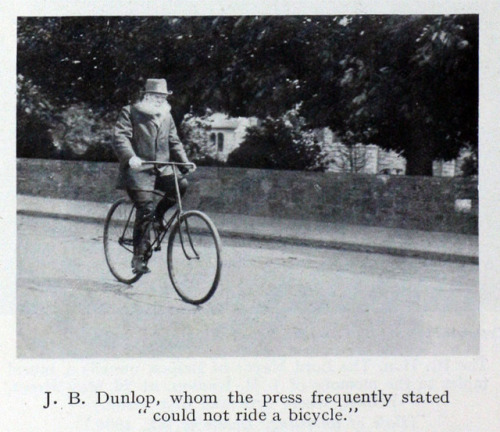
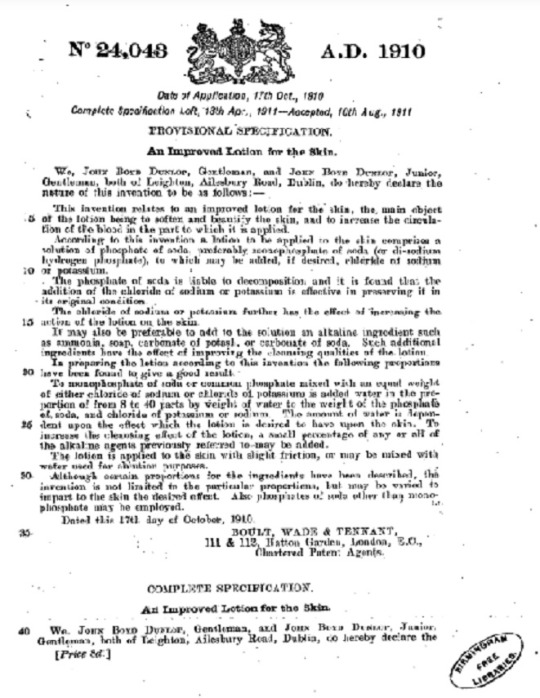
John Boyd Dunlop, who patented the first practical practical pneumatic tyre, was born in Ayrshire on February 5th 1846.
Notice I didn’t say invented there, because he might have perfected the tyre but he didn’t come up with the idea, it was another clever Scot called Robert William Thomson who made the first pneumatic tyre on 10 December 1845, some 43 years before John Dunlop’s re-invention, it was way too soon for the world to appreciate it though, so on this day in 1846 a Scotsman re-invented the wheel...sort of :)
John Boyd Dunlop was a veterinary surgeon from Scotland who had settled in Belfast in Northern Ireland. He didn't really have much to do with then newfangled driving devices like the bicycle, but is said to have worked a lot with rubber in his practice. To make his son's tricycle faster and more comfortable, he tinkered with the sheathing of the wheels. He developed a rubber tube that was wrapped in canvas and glued to a wooden rim. A baby's dummy is said to have served as a valve.
With this air-filled tyre, Dunlop junior whizzed happily along the streets of Belfast in the spring of 1888, easily outstripping his comrades. Dunlop realised that the pneumatic tyre held great promise and successfully applied for a patent for his invention at the end of the same year. This marked the beginning of the rise of the Dunlop brand, which is still famous today (including 129659, DE word mark since 1910; DE756765 or EM005125489).
But: Dunlop should never have been granted this patent. The UK Patent Office had overlooked the fact that someone else had already received the patent for a pneumatic tyre some 40 years earlier. Robert William Thomson (1822-1873) was also Scottish and an extremely talented inventor. At the age of 23, he was granted pneumatic tyre patents in France and the USA ( US5104A). His tyre consisted of a hollow belt of Indian rubber inflated with air and covered with a leather casing. The wheels laid, as it were, "a cushion of air on the ground, rail or track" on which they ran. Thomson demonstrated his "Aerial Wheels" on horse-drawn carriages in London's Regent's Park in March 1847.
But unfortunately the time was not yet ripe for his invention. Like many other ingenious inventor´s ideas, Thomson´s tyre fell into oblivion. But he was luckier with other projects. He developed, among other things, the fountain pen, new types of steam engines and electric ignition devices for blasting, which greatly advanced railway construction. He died a rich and respected man.
John Boyd Dunlop is said to have known nothing of his compatriot's invention when he registered his idea with the patent office. He further improved his pneumatic tyres and had a series of 50 bicycles fitted with them. With one of these bicycles, William Hume, the previously unsuccessful captain of the Belfast Cruisers' Cycle Club, suddenly achieved spectacular success in bicycle races.
Among others, Hume beat the national champion Arthur Du Cros on 18th May 1889. The latter's father, the entrepreneur William Harvey Du Cros, recognised the marketing potential of the invention. He sought contact with Dunlop and together they founded the "Pneumatic Tyre & Booth's Cycle Agency" in Westland Row in Dublin on 18th November 1889, which was soon renamed "Dunlop Pneumatic Tyre Co. Ltd". The triumphant advance of the pneumatic tyre began.
At the first Olympic Games in Athens in 1896, all cyclists competed with pneumatic tyres.
However, as the invention became more widely known, Thomson's patent came to light again. Dunlop initially lost his patent. The brothers Edouard and André Michelin from Clermont-Ferrand took advantage of this and produced pneumatic tyres on a large scale. They were also the first to equip the emerging automobile with tyres, thus considerably accelerating its success story.
Dunlop continued to further develop the tyre and was able to obtain new patents for his improvements, which ensured his economic success
Above all, the valve, which is still named after him today, proved that he was an able inventor. Incidentally, he also applied for patents for developments in completely different fields, such as a skin lotion as seen in the pics.
Only four years after the foundation of his company, Dunlop's first foreign branch was established in Hanau. It still exists today. Dunlop was soon to manufacture numerous other rubber products such as golf and tennis balls, floor coverings and brake shoes. The company became one of the first "global players", a worldwide manufacturing company.
John Boyd Dunlop withdrew completely from the company in 1895 and returned to his veterinary practice. Along the way, he and his son worked on new inventions, such as a patented eau de toilette.
14 notes
·
View notes